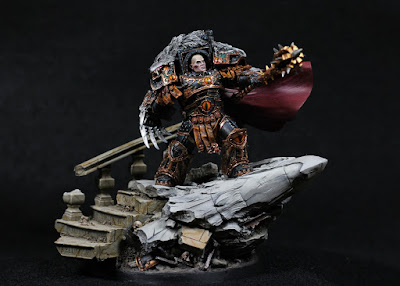 |
| Yellow Man. |
This series might take a little while to get posted, as I'm intending to write out everything in steps, then post everything at once or in short succession.
This is the Forgeworld Avatar of Khaine, spear version. As is typical from Forgeworld, the detail is incredible, and will help in painting this monster. There are very few defects in the model as well, only minor places that were easily fixed with either a bit of putty, or closed up with a dot of superglue. I was concerned with the weight and how few contacts points on the base there are, so that has been pinned and glued. I intend to strengthen the pins with some putty underneath as well, but for not it's a solid connection to the base.
This Avatar will be Ulthwe, with a few tweaks to match that. Shin and forearm armour (decorative only when it comes to an Avatar) I'll go for a bone colour, and generally black elsewhere. This lends itself naturally to the typical magma appearance most commonly painted, and I'm not inclined to make something different right now.
To start with, the model was of course fully cleaned and then primed black. A necessary step with resin, as other layers will easily come off if this isn't done. I then had the clever idea of using an airbrush to spray white into all the magma cracks - only it wasn't that clever. The paint didn't really want to go into the cracks at all, so I ended up just giving the whole model a light "dusting" of White Scar through the airbrush. I'd thinned the paint well beforehand, making it more of a white ink than anything else.
Fortunately the initial white layer helped more than hindered in the end. It picks out details clearly, and serves as a good base for working with Contrast paints. It's also much finer than using a spray can, so I'm going to keep this in mind in future.
Back to a paintbrush, I thinned White Scar with a good amount of flow improver (basically Lahmian Medium) to turn it into a wash, and then directly fed it into all the cracks and left it to dry. This process was repeated about four times until a solid white built up. It's good to allow this to spill over the cracks as well, so don't worry about that.
Next step is to cover all these areas with Lamenters Yellow, the good old glaze paint. I liked the yellow this gives - a very bright, but pale, yellow that fits for the fiery core of the Avatar.
Next is Iyanden Yellow (Contrast). This is basically thinly applied over most of the "skin" but not in the deep of the cracks. Sides, and upper layers, and anywhere that should be ever so slightly cooler. Despite the name, the paint actually appears ever so slightly orange in comparison to the previous step.
Following on, Blood Angels Red (Contrast). This is quite a strong paint, so thin it with contrast medium about 1:1, or even 1:2. This mix is then glazed onto the skin, slightly back from the cracks, and blended where possible into the edges. Use as many coats as feels right.
Finally, Black Templar (Contrast), thinned with the medium in about 1:1 and applied further back from the cracks and given multiple coats to really darken the areas between the cracks.
I've not yet done anything further, but I'm contemplating a slight drybrush of something onto the blackened areas just to give them a little bit more depth. Picking the right colour will be key, so I'll wait until I've gone around the whole model with the contrast paints first, and then see how it looks.
The base has very few adornments. I'd considered buying a specialty base, but will probably just go for some freehand wraithbone styling and then build up scorch marks around it. Plenty of time to think about that step.
-- silly painter.




























